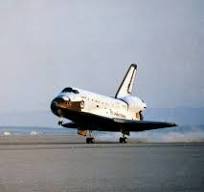
April 13, 1984: This isn’t Florida! Challenger’s landing, diverted to Edwards Air Force Base, kicks up California dust on the dry lakebed.
*****
The Solar Max satellite, restored and released yesterday, let go from the robot arm with “zero rates,” meaning no stray motions, has left home, and today, April 13, 1984, marks our day to fly Challenger home. Aiming for a landing at the Kennedy Space Center, we’re looking for April 13 — Friday the 13th, no less, and the 14th anniversary of the Apollo 13 oxygen-tank explosion — to prove lucky for us, STS-41C, once known as STS-13. And at 3 a.m. (all times EST), the weather over the Kennedy Space Center is clear and looking go for a landing at 7:07 a.m. We radio, “Tell John to work on the weather, keep it good.” That’s a message for fellow astronaut John Young, flying weather watch over Kennedy’s Shuttle landing strip.
The Houston capcom replies, “Will do. There are lots of folks there at the Cape waiting for you.” At 5:36 a.m., as we fly over Dakar, West Africa, we’re given a go for Kennedy, 24 min. until the deorbit burn. Especially welcome news for our commander, Bob “Crip” Crippen. He was slated to fly the first landing at Kennedy on STS-7 but bad weather forced the flight to be diverted to Edwards Air Force Base California. “And what we expect in the area is a scattered [cloud] deck about 8 – 9,000 ft.”
Just 8 min. from moving out of communications range, with the deorbit burn to begin a minute later, Houston, at this late moment, calls, “Crip, some little discouraging words. We’d like to wave of for one rev. We’ve got real low deck at about 2,000 ft. that’s starting to move in and thicken up. We’re hoping it’s going to go away in 2 1/2 hrs.
“OK, we understand.” That was close. Too close. Landing one-orbit late will put us on the ground at 8:47 a.m. Doesn’t sound like the clouds will clear in time.
Houston says, “Just for your planning purposes. . . if KSC continues to look bad, we may end up going into Edwards today after all. And we’ll have that decision to you, hopefully, over the States.”
Crip replies, “OK, that sounds fine, thanks. It’s like I’ve been there before.”
“Yes, sir. and Gary [Flight Director Gary Coen] would like to pass up, ‘So have we.'”
At 6:35 a.m., a half hour before we’d commit to a Kennedy landing, Capcom Guy Gardner prepares to read up the “pad,” the data for the deorbit burn. Then stops. “We’d like to hold off on these pads because its looking strong for Edwards now, and we’re going to make a decision soon due to the rain in the vicinity of KSC.”
“OK, that makes sense. No sense copying numbers just to copy numbers.”
“. . .The KSC weather’s getting worse with rain showers. Tomorrow looks about the same. So we’ll be going to Edwards this rev.”
It’s real now, we focus on a return on our 107th orbit, with our deorbit burn just an hour away. Swiftly, we must realign two of three Inertial Measurement Units to synch with the primary. And reconfigure our computers for an Edwards landing, lakebed runway 17.
When we pass over the Cape, Crip tells capcom Guy Gardner, “Guy would you send my regrets to the folks at KSC. Tell them they’ve got to work a little harder on the weather there.”
Our pilot, Dick Scobee, adds, “Crip’s been doing this with the weather every we’ve been flying with him, Guy.”
Over Dakar, Guy gives us the good word. “Challenger, Houston, you’re go for deorbit burn.” Now it really is real. Dick Scobee starts the three Auxiliary Power Units that bring our hydraulic systems to life.
At 7:29 a.m., over the Indian Ocean, we burn our two OMS engines for 4 min. 8 sec. We can report to Houston, “Burn was nominal and on time.”
And a half hour later, touch the first fringes of atmosphere, entry interface. As we are about to enter communications blackout, Guy radios, “Have a good entry. We’ll see you at Mach 12.”
“Wish you could see this,” we tell him. The ionized glow begins to envelope the Shuttle.
The Shuttle rolls on a left bank to correct our course for Edwards. And then we — or I should say the computers — fly a series of S-turns to bleed off velocity.
We cross the coast and approach the desert. It’s 15 min. since dawn. There’s Edward, we make a wide left turn around the heading alignment circle to line up with runway 17, a 7-mile-long runway etched in the dry lakebed.
“Challenger, Houston. Looking good on final. Winds are calm.”
“That’s my kind of winds.” We’re an 6,000 ft. and dropping toward the threshold. And Crip brings her in, landing at 8:38 a.m. EST (5:38 a.m., Pacific time). Our flight of 6 days, 23 hrs. 40 min. and 54 sec. is over.
“Houston, Challenger is wheels stop.”
“Roger, welcome back on Friday the 41 charlie.” Our flight number replaces the date.
And later we learn that at our landing time, it was raining at the Kennedy Space Center.